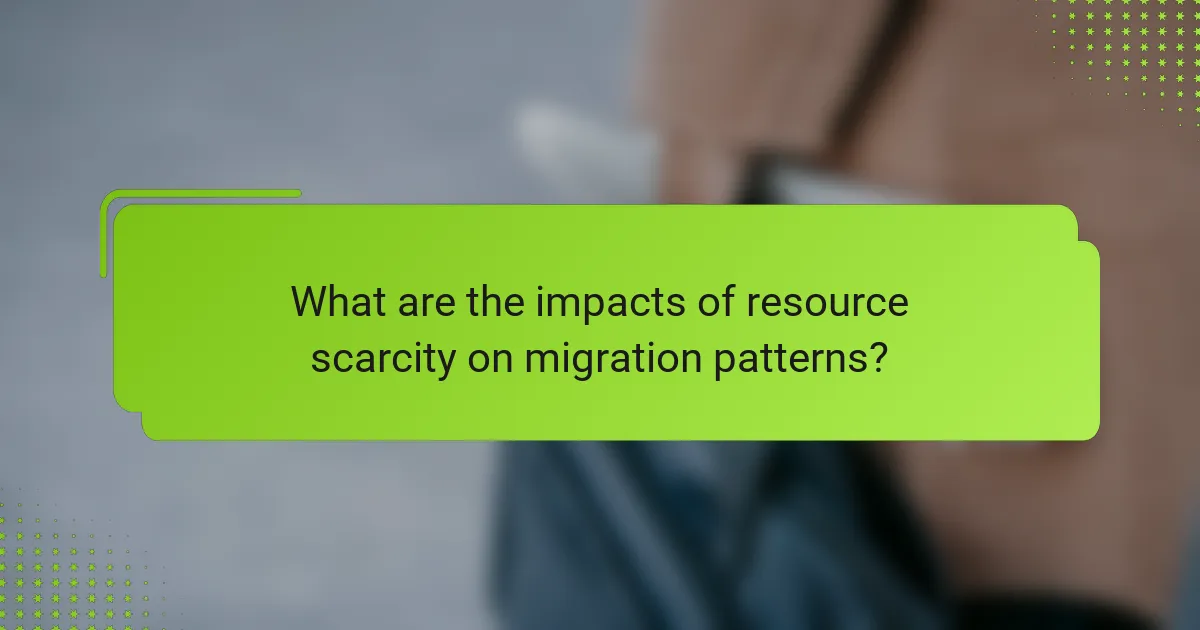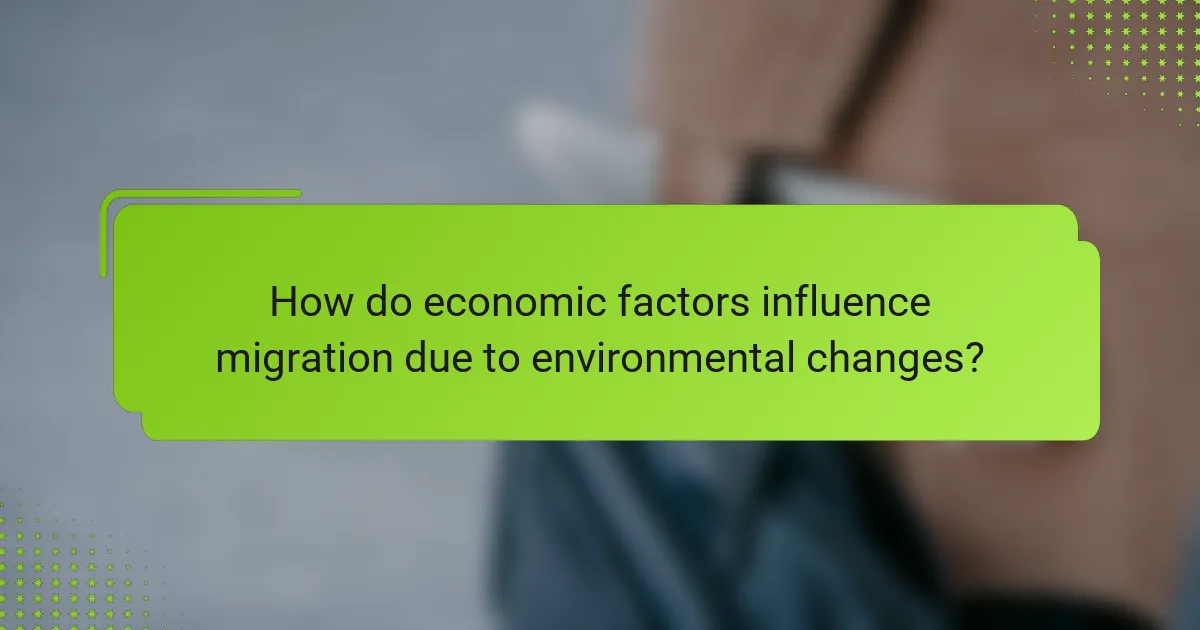Environmental changes, driven by climate impact and resource scarcity, are reshaping migration patterns across the globe. As essential resources like water and arable land become increasingly limited due to shifting weather patterns, populations are compelled to seek new opportunities and better living conditions. Addressing these challenges requires sustainable practices that enhance community resilience and reduce vulnerability to climate-related disruptions.

What are the impacts of resource scarcity on migration patterns?
Resource scarcity significantly influences migration patterns, particularly in regions where essential resources like water and arable land become limited. As these resources dwindle, populations are forced to relocate in search of better living conditions and opportunities.
Increased displacement in vulnerable regions
Vulnerable regions, often characterized by economic instability and environmental challenges, experience heightened displacement due to resource scarcity. For example, areas in sub-Saharan Africa face severe droughts that diminish agricultural output, prompting families to migrate to urban centers or neighboring countries for survival.
Additionally, conflicts over dwindling resources can exacerbate tensions, leading to further displacement. Communities that rely heavily on agriculture or fishing may find themselves uprooted as their livelihoods are threatened, resulting in a cycle of migration that can destabilize entire regions.
Urban migration trends in developing countries
In developing countries, urban migration trends are increasingly linked to resource scarcity. As rural areas become less viable due to factors like soil degradation and water shortages, individuals and families are drawn to cities in search of employment and better living conditions.
This urban influx can strain city infrastructure and services, leading to challenges such as overcrowding and inadequate housing. Governments and organizations must address these issues by investing in sustainable urban planning and resource management to accommodate the growing populations effectively.

How does climate change affect resource availability?
Climate change significantly impacts resource availability by altering weather patterns, which affects both natural resources and human access to them. As temperatures rise and precipitation patterns shift, the availability of essential resources like water and arable land becomes increasingly strained.
Decreased freshwater supplies
Climate change leads to decreased freshwater supplies due to altered rainfall patterns and increased evaporation rates. Regions that traditionally rely on consistent rainfall may experience prolonged droughts, reducing surface water and groundwater levels.
For instance, areas in Southern Europe and parts of the United States are already facing water scarcity, which can lead to restrictions on water usage and increased competition among agricultural, industrial, and residential sectors. Communities may need to adapt by implementing water conservation measures and investing in technologies for water recycling.
Impact on agricultural productivity
Changes in climate directly affect agricultural productivity by altering growing seasons and crop yields. Warmer temperatures can lead to heat stress in crops, while shifting rainfall patterns may cause either flooding or drought, both of which can devastate harvests.
Farmers may need to adjust their practices, such as selecting more resilient crop varieties or adopting new irrigation techniques, to cope with these changes. In regions like Sub-Saharan Africa, where agriculture is heavily dependent on rain, the impact can be particularly severe, potentially leading to food insecurity and increased migration as people seek better living conditions.

What strategies can mitigate climate impact on communities?
To effectively mitigate climate impact on communities, strategies must focus on sustainable practices that enhance resilience and reduce vulnerability. Key approaches include investing in sustainable agriculture and developing water conservation technologies.
Investment in sustainable agriculture
Investing in sustainable agriculture involves adopting practices that improve soil health, increase biodiversity, and reduce dependency on chemical inputs. Techniques such as crop rotation, agroforestry, and organic farming can enhance food security while minimizing environmental degradation.
Farmers can also benefit from training programs that promote sustainable methods and access to resources like drought-resistant seeds. This investment not only supports local economies but also helps communities adapt to changing climate conditions.
Development of water conservation technologies
Developing water conservation technologies is crucial for communities facing water scarcity due to climate change. Solutions such as rainwater harvesting systems, drip irrigation, and greywater recycling can significantly reduce water usage and improve efficiency.
Implementing these technologies often requires initial investment but can lead to long-term savings and increased water availability. Communities should consider local conditions and available resources when selecting appropriate technologies to ensure effectiveness and sustainability.

What role do governments play in addressing resource scarcity?
Governments play a crucial role in addressing resource scarcity by implementing policies and regulations that promote sustainable management of natural resources. They can influence resource allocation, conservation efforts, and the development of technologies that mitigate the impacts of scarcity.
Policy frameworks for resource management
Effective policy frameworks are essential for managing resources sustainably. Governments can establish regulations that limit over-extraction and promote conservation practices, such as water-saving technologies in agriculture or renewable energy incentives. For instance, implementing laws that require industries to reduce waste can significantly impact resource availability.
Additionally, governments can create economic incentives, such as tax breaks or subsidies, to encourage businesses and individuals to adopt sustainable practices. Clear guidelines and standards help ensure that resources are used efficiently and responsibly, benefiting both the economy and the environment.
International cooperation on climate initiatives
International cooperation is vital for addressing resource scarcity linked to climate change. Governments can collaborate through treaties and agreements to share best practices and technologies that enhance resource management. Initiatives like the Paris Agreement encourage countries to commit to reducing greenhouse gas emissions, which can alleviate some pressures on resources.
Moreover, joint efforts in research and development can lead to innovative solutions for resource scarcity. Countries can pool resources to fund projects that focus on sustainable practices, such as developing drought-resistant crops or improving water management systems. This collaborative approach can lead to more effective and widespread solutions to resource challenges globally.

How do economic factors influence migration due to environmental changes?
Economic factors significantly influence migration patterns as individuals and families seek better opportunities in response to environmental changes. When resources become scarce or regions face climate-related challenges, people often move to urban areas where job prospects are more favorable.
Job opportunities in urban centers
Urban centers typically offer a wider array of job opportunities compared to rural areas, especially during times of environmental stress. For instance, cities may attract migrants looking for employment in sectors like construction, renewable energy, and technology, which often experience growth as communities adapt to climate change.
Moreover, urban areas may provide better access to education and training programs, enabling migrants to enhance their skills and improve their employability. This dynamic can create a cycle where increased migration leads to economic growth, further attracting more individuals seeking better livelihoods.
Economic instability in affected regions
Regions severely affected by environmental changes often experience economic instability, which can drive migration. Factors such as crop failures, water shortages, and natural disasters can destabilize local economies, leading to job losses and reduced income for families.
In such scenarios, individuals may feel compelled to leave their homes in search of more stable economic conditions. For example, farmers facing persistent droughts may migrate to cities where they can find alternative work, contributing to urban population growth and changing demographic patterns.

What are the long-term effects of climate-induced migration?
Climate-induced migration leads to significant long-term effects on both the migrants and the regions they leave or move to. These effects include shifts in demographic patterns and increased pressure on social services and infrastructure in receiving areas.
Changes in demographic patterns
Climate-induced migration alters demographic patterns by increasing the population in certain areas while depleting others. For instance, regions facing severe droughts may see a mass exodus, leading to a decline in local populations, while urban centers may experience rapid growth as migrants seek better opportunities.
This shift can create a younger demographic in receiving areas, as many migrants are of working age. However, it may also lead to challenges such as cultural integration and potential tensions between migrants and local residents.
Impact on social services and infrastructure
The influx of migrants can strain social services and infrastructure in host communities. Schools, healthcare facilities, and housing may become overwhelmed, leading to decreased quality of services and increased wait times. For example, a sudden increase in population can result in overcrowded classrooms and longer lines at clinics.
Local governments often face challenges in funding and planning for these changes. It is crucial for policymakers to anticipate these impacts and invest in infrastructure improvements and social services to accommodate the growing population effectively.

What emerging trends are shaping future migration patterns?
Emerging trends influencing future migration patterns include climate change, resource scarcity, and socio-economic factors. These elements are driving people to relocate in search of better living conditions and opportunities.
Climate Change and Migration
Climate change significantly impacts migration by altering weather patterns, increasing the frequency of natural disasters, and affecting agricultural productivity. Regions facing severe droughts or flooding often see a rise in out-migration as residents seek more stable environments.
For instance, areas in sub-Saharan Africa and parts of South Asia are experiencing heightened migration due to extreme weather events. This trend is expected to continue, with millions potentially displaced by climate-related factors in the coming decades.
Resource Scarcity as a Driver
Resource scarcity, particularly concerning water and arable land, is a critical driver of migration. As populations grow and resources become limited, individuals and families may move to areas where these essentials are more accessible.
In regions like the Middle East and North Africa, competition for water resources has already led to increased migration. Countries facing severe water shortages may see their citizens relocating to neighboring nations with better access to water.
Economic Factors and Migration Trends
Economic opportunities play a significant role in shaping migration patterns. People often migrate from regions with limited job prospects to urban areas or countries offering better employment opportunities.
For example, many individuals from Eastern Europe have migrated to Western Europe in search of higher wages and improved living standards. This trend reflects a broader pattern where economic disparities drive migration, creating a dynamic labor market across borders.



